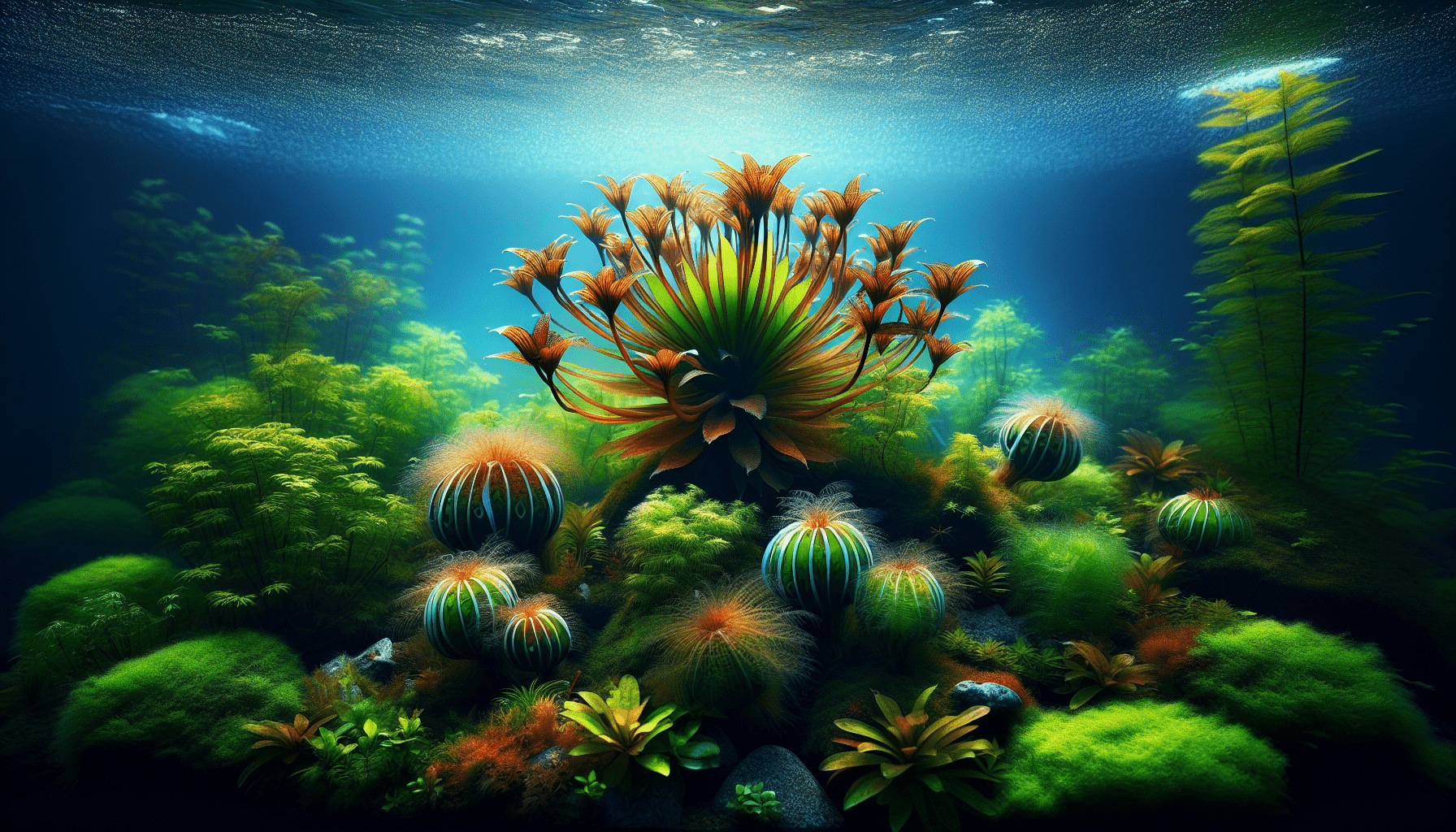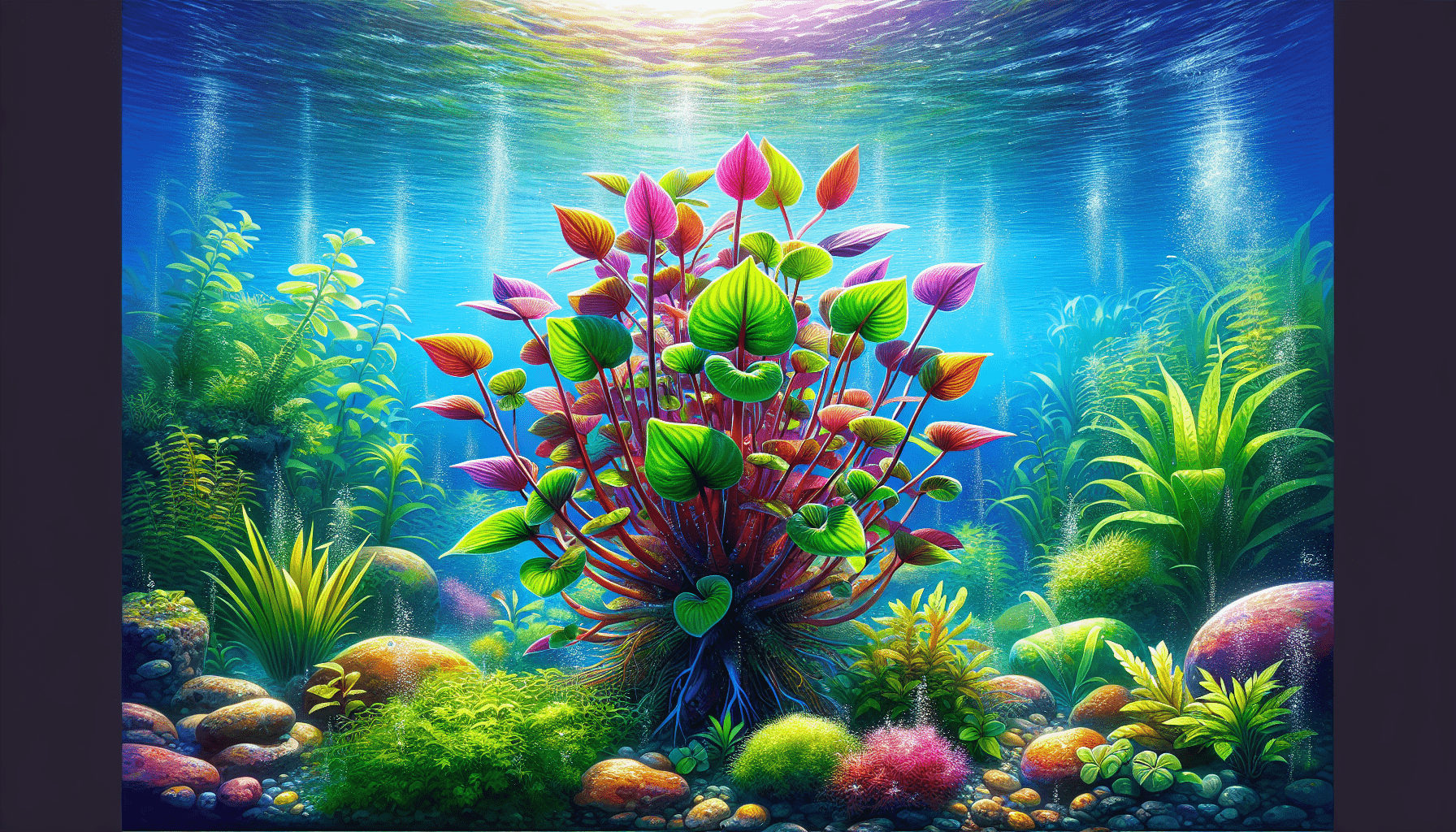As you embark upon the exploration of the intriguing world of aquatic plant life, you may find yourself drawn towards the unique, vibrantly hued specimen known as Cuban Ludwigia. This aquatic plant, with its rich coloration and intricate growth patterns, holds a singular place amongst its freshwater counterparts. Not only an aesthetic enhancer in aquatic environments, the Cuban Ludwigia plays distinct ecological roles in supporting biodiversity, and also presents an interesting study in regards to its cultivation and propagation methodologies. Your inquisitiveness in the field of botany is about to be rewarded as you unravel the attributes, lifestyles, and importance of this plant.

Overview of Cuban Ludwigia
In the world of aquatic plants, the Cuban Ludwigia stands out for its remarkable adaptability and unique characteristics.
Definition of Cuban Ludwigia
Cuban Ludwigia is a submersed freshwater perennial plant from the genus Ludwigia, in the Onagraceae family. Its scientific name, Ludwigia inclinata, refers to the leaning or inclined nature of its stems.
Origins and Distribution
Cuban Ludwigia naturally grows in the neotropical region. Specifically, it is native to Cuba and other parts of the Caribbean, South America, and Central America. However, due to its popularity as an aquarium plant, it now has a distribution that spans across numerous countries, even reaching the tropical regions of Asia.
Common Names and Synonyms
Cuban Ludwigia is also known by various common names such as Twisted Ludwigia or Leaning Primrose-Willow. The scientific synonyms for this plant include Ludwigia cubensis, Ludwigia elegans, and Ludwigia tortuosa which refer to its Cuban origin, distinctive elegance, and twisted stem structure.
Morphological Characteristics
Cuban Ludwigia is recognized for its distinct features, remarkable growth patterns, and aesthetic appeal.
General Appearance
Generally, Cuban Ludwigia exhibits a vibrant array of colors that shift between green, red, and orange, depending on the lighting conditions. Its textured, multi-branched stems give rise to an impressive bushy appearance, making it a popular choice for those desiring a lush and vibrant aquatic environment.
Root System
Much like other aquatic plants, Cuban Ludwigia has a well-developed root system that anchors the plant in soft substrates. The roots also contribute to the uptake of nutrients necessary for plant growth and survival.
Leaf Structure
Cuban Ludwigia has alternating oval to elliptical leaves. The leaves are distinctly serrated, grow oppositely along the stem, and showcase diverse hues of green and red.
Flowering System
The flowering system of Ludwigia inclinata consists of small yellow flowers that bloom above the water surface. These flowers, though simple, contribute to the overall ornamental value of this species.
Cuban Ludwigia in Aquatic Ecologies
In its native aquatic habitats, Cuban Ludwigia plays multiple ecological roles.
Role in the Ecosystem
Cuban Ludwigia serves as a natural water purifier, regulator of water temperature, facilitator of nutrient cycling, and also provides habitat for several aquatic organisms. It is a vital food source for a variety of herbivorous creatures in the freshwater ecosystem.
Impact on Local Biodiversity
By providing food and shelter, Cuban Ludwigia contributes greatly to local biodiversity. However, when introduced into non-native areas, it can potentially become invasive and threaten indigenous species, warranting regular monitoring and care to prevent unwanted propagation.
Interactions with Other Aquatic Species
The existence of Ludwigia inclinata significantly influences the population and behavior of other species in the aquatic environment. For instance, it symbiotically interacts with a myriad of aquatic organisms that can use the dense foliage for cover, breeding, and feeding.

Growth and Reproduction
The growth and reproduction habits of Cuban Ludwigia make it a fascinating plant for both hobbyists and scientists.
Growth Rate and Lifespan
Cuban Ludwigia is characterized by rapid growth and can reach a height of up to 2 meters in optimal conditions. Despite its quick lifespan, its vast propagative abilities ensure its continuity in suitable ecosystems.
Seeding and Germination Process
The reproduction of Cuban Ludwigia mainly occurs vegetatively. Fragments of the stem, once detached, quickly root in the substrate to create a new plant. However, sexual reproduction is also possible through the development of seeds in its flowers, given the appropriate environmental conditions.
Reproductive Strategies
Another important reproductive strategy of Ludwigia inclinata is the formation of overwintering buds known as turions, allowing it to survive colder periods. These buds remain dormant until conditions become favorable for growth and propagation.
Adaptations for Aquatic Life
Several biological adaptations make the Cuban Ludwigia a perfect candidate for survival in aquatic conditions.
Adaptable Conditions
The species demonstrates a great deal of adaptability and resilience, surviving in a range of aquatic conditions from stagnant ponds to fast-flowing streams. The adaptable nature of Cuban Ludwigia contributes significantly to its survival and uniform spread.
Tolerance to Various Environments
Cuban Ludwigia reveals high tolerance to various environmental stresses such as fluctuations in temperature, light intensity, and water chemistry. This trait allows the plant to thrive under diverse aquatic environments.
Water-Type Requirements
To promote optimal growth, Cuban Ludwigia needs a combination of soft and hard water rich in nutrients. Nonetheless, it can tolerate significant variations in water conditions due to its robust and resilient nature.
Cuban Ludwigia as an Aquarium Plant
The charisma of Cuban Ludwigia has not escaped the attention of aquarium hobbyists and professionals.
Benefits for Aquarium Life
Cuban Ludwigia is often included in aquariums for its aesthetic appeal and its capacity to improve water quality. Furthermore, it provides habitat and breeding space for various aquarium inhabitants.
Maintenance and Care in An Aquarium
While Cuban Ludwigia is not particularly demanding, it appreciates a nutrient-rich substrate, adequate lighting, and a temperature range of 22-28 degrees Celsius. Regular pruning is also required to maintain shape and facilitate healthy growth.
Potential Challenges and Solutions
Despite its adaptation to a wide range of conditions, Ludwigia inclinata may face pest and disease challenges. Vigilance and regular maintenance can detect and control these issues before they significantly impact the plant.
Commercial Significance of Cuban Ludwigia
Cuban Ludwigia has gradually carved out a role for itself in the commercial world.
Use in Aquarium Trade
Cuban Ludwigia has considerable commercial value in the global aquarium trade due to its ease of culture, rapid growth, and ability to enhance the aesthetics of an aquarium.
Role in Ornamental Water Gardens
Aside from aquariums, Cuban Ludwigia is also utilized as an ornamental plant in water gardens for its bright foliage and attractive flowers.
Medicinal and Nutritional Value
The use of Cuban Ludwigia for medicinal and nutritional purposes is not fully explored. However, some preliminary research hints at its potential nutritional value and bioactive compounds, necessitating further investigations.
Conservation Status and Threats
Given the increasing importance of Cuban Ludwigia, issues concerning its conservation and threats need to be addressed.
Current Conservation Status
As Cuban Ludwigia is not currently classified as vulnerable or endangered, no specific conservation status is assigned to it. Its immense range and adaptable nature make it relatively secure.
Threats to Population
The main threats to Ludwigia inclinata populations include habitat loss, environmental pollution, and over-exploitation for commercial purposes.
Conservation Efforts and Strategies
Preserving native habitats, controlling the discharge of contaminants into water bodies, and regulating trade can help with the long-term survival of this species. Greater awareness about the ecological importance of Cuban Ludwigia can also improve conservation efforts.
Cuban Ludwigia and Environmental Impact
Although little information is available on this specific subject, Cuban Ludwigia likely performs essential environmental functions.
Pollution Tolerance
With an ability to tolerate polluted conditions, Ludwigia inclinata may play a significant role in bio-filtration and water purification.
Potential as Bio-indicators
Given its sensitivity to changes in water chemistry and light conditions, it may serve as potential bio-indicators of aquatic health.
Impact on Water Quality
By absorbing excess nutrients, Cuban Ludwigia can maintain water quality and prevent eutrophication.
Future of Cuban Ludwigia
The future of Cuban Ludwigia demands thoughtful consideration and further research.
Impact of Climate Change
Climate change poses uncertainties to the habitats of Cuban Ludwigia, with potential alterations in water temperature and chemistry influencing its distribution and growth.
Projecting Population Trends
With its wide range and high adaptability, the future population of Ludwigia inclinata looks promising. Yet, ongoing environmental changes may affect this projection.
Future Research Directions
Understanding the ecology, adaptability, and environmental impact of Ludwigia inclinata can be a major focus for future research. Its unrealized potential in phytoremediation, bio-indication, and pharmaceutical sectors can also be explored in future studies.